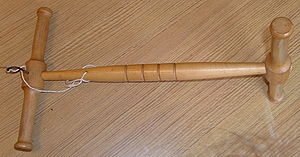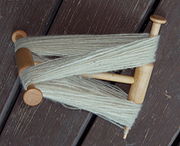
Niddy noddy
Encyclopedia

Skein
Skein may refer to:* A flock of geese or ducks in V formation flight* A wound ball of yarn with a center pull strand, see hank* TV Series, used part of Variety's slanguage.* Skein dubh, a Scottish knife* Skein module, a mathematical concept...
s from yarn
Yarn
Yarn is a long continuous length of interlocked fibres, suitable for use in the production of textiles, sewing, crocheting, knitting, weaving, embroidery and ropemaking. Thread is a type of yarn intended for sewing by hand or machine. Modern manufactured sewing threads may be finished with wax or...
. It consists of a central bar, with crossbars at each end, offset from each other by 90°. The central bar is generally carved to make it easier to hold. Either one of the crossbars will have a flat edge to allow the skein to slide off, or will be completely removable. Niddy-noddies can be constructed of many different materials including wood, metal, and plastic. Wood is traditional, and most quality niddy-noddies are still made of wood. Budget spinners
Spinning (textiles)
Spinning is a major industry. It is part of the textile manufacturing process where three types of fibre are converted into yarn, then fabric, then textiles. The textiles are then fabricated into clothes or other artifacts. There are three industrial processes available to spin yarn, and a...
occasionally use niddy-noddies made from PVC
PVC
Polyvinyl chloride is a plastic.PVC may also refer to:*Param Vir Chakra, India's highest military honor*Peripheral venous catheter, a small, flexible tube placed into a peripheral vein in order to administer medication or fluids...
pipes.
Manufactured niddy-noddies can be made of different sizes, producing skeins from 12 inches in length to 4 feet in length. The most common size, however, produces a two yard skein. Very small niddy-noddies are generally used for small samples. Many spinners will spin a sample length of yarn, ply it, and skein it using a niddy-noddy before washing. Then the spinner can see if the yarn is as desired or not.
By counting the number of wraps for the skein, and measuring the length of one wrap, the approximate yardage can be calculated. The yardage is approximate because an exact yardage requires an even tension throughout wrapping the whole skein. Also, a very large skein requires wrapping the new layers on top of the old, which increases the length of the top layers.
A niddy-noddy, though apparently one with the crossbars parallel, is held by Christ in Leonardo da Vinci
Leonardo da Vinci
Leonardo di ser Piero da Vinci was an Italian Renaissance polymath: painter, sculptor, architect, musician, scientist, mathematician, engineer, inventor, anatomist, geologist, cartographer, botanist and writer whose genius, perhaps more than that of any other figure, epitomized the Renaissance...
's Madonna of the Yarnwinder
Madonna of the Yarnwinder
The Madonna of the Yarnwinder is the subject of several oil paintings, but the original version by Leonardo da Vinci may now be lost. The composition shows Virgin Mary with the Christ child, who looks longingly at a yarnwinder used to collect spun yarn...
in Edinburgh.
Use

Spinning (textiles)
Spinning is a major industry. It is part of the textile manufacturing process where three types of fibre are converted into yarn, then fabric, then textiles. The textiles are then fabricated into clothes or other artifacts. There are three industrial processes available to spin yarn, and a...
or plying
Plying
In the textile arts, plying is a process used to create a strong, balanced yarn. It is done by taking two or more strands of yarn that each have a twist to them and putting them together. The strands are twisted together, in the direction opposite that in which they were spun...
. This is because after spinning or plying the yarn generally gets washed, and a skein is the best form to have the yarn in for washing. Rarely is yarn taken from a ball and skeined, as balls are easier for knitters
Knitting
Knitting is a method by which thread or yarn may be turned into cloth or other fine crafts. Knitted fabric consists of consecutive rows of loops, called stitches. As each row progresses, a new loop is pulled through an existing loop. The active stitches are held on a needle until another loop can...
and crocheters
Crochet
Crochet is a process of creating fabric from yarn, thread, or other material strands using a crochet hook. The word is derived from the French word "crochet", meaning hook. Hooks can be made of materials such as metals, woods or plastic and are commercially manufactured as well as produced by...
to use because they don't get tangled as easily.
When skeining from wheel
Spinning wheel
A spinning wheel is a device for spinning thread or yarn from natural or synthetic fibers. Spinning wheels appeared in Asia, probably in the 11th century, and very gradually replaced hand spinning with spindle and distaff...
spun yarn, the bobbin
Bobbin
A bobbin is a spindle or cylinder, with or without flanges, on which wire, yarn, thread or film is wound. Bobbins are typically found in sewing machines, cameras, and within electronic equipment....
can either be removed from the wheel and placed on a lazy kate
Lazy Kate
In spinning, a lazy kate is a device used to hold one or more spools or bobbins in place while the yarn on them is manipulated. Typically, a lazy kate consists of multiple rods and come with bobbins that fit onto them. Tensioned lazy kates have a band that loops over the bobbins to prevent the...
, or skeined directly from the wheel. If the bobbin is left on the wheel the tension on the drive band must be lessened in order to allow the bobbin to turn freely. Yarn spun on spindle
Spindle (textiles)
A spindle is a wooden spike used for spinning wool, flax, hemp, cotton, and other fibres into thread. It is commonly weighted at either the bottom middle or top, most commonly by a circular or spherical object called a whorl, and may also have a hook, groove or notch, though spindles without...
s can either be left on the spindle, or slipped onto a dowel for plying. The spindle or dowel is either placed in a lazy kate, or even a bowl to keep the spindle in one place while winding off the yarn.
One end of the yarn is wound around the center piece and held firmly in place, while the rest of it is wrapped. The yarn is then taken over the left end of the top crossbar, down and under the right side of the lower crossbar, up and over the other end of the top crossbar, and then down and under the other end of the lower crossbar before returning to the starting point to complete one wrap. While rather awkward at first, one quickly picks up the rhythm.
This process continues until the whole skein is wound. The time to skein yarn on a niddy-noddy depends on the yardage, and thus how many wraps need to be made. A larger niddy-noddy can speed up the skeining, but a very large one can be bulky, and thus slow down the time to do one wrap. At this point, the skein is secured by loose figure eight knots between each crossbar. This can be done with scrap yarn, or with slip knots
Slip knot
A slip knot is one of two different classes of knot. The most common are knots which attach a line to an object and tighten when tension is applied to the free end of the line...
from the end of the skein. In either case, loosely securing each end with a slip knot
Slip knot
A slip knot is one of two different classes of knot. The most common are knots which attach a line to an object and tighten when tension is applied to the free end of the line...
makes it easier to find the ends in the finished skein. Generally 4 or more knots are tied.
Once the yarn has been skeined, it can be dyed or washed to set the twist. Weavers
Weaving
Weaving is a method of fabric production in which two distinct sets of yarns or threads are interlaced at right angles to form a fabric or cloth. The other methods are knitting, lace making and felting. The longitudinal threads are called the warp and the lateral threads are the weft or filling...
often dry their yarn under tension with a weight at the bottom of the loop, to stretch it out and remove some of the elasticity.
Traditionally the niddy-noddy was used to the rhythm of a song, the opening line of which ran, ‘Niddy-noddy, niddy-noddy, two heads and one body.’
Other skein winders
The closest tools similar to a niddy-noddy are the swiftSwift (textiles)
For other uses, see Swift A swift is a tool used to hold a skein of yarn while it is being wound off. It has an adjustable diameter so that it can hold skeins of many sizes, and rotates around a central rod. They are generally made out of wood or metal, however other materials may also be used...
, and the spinners weasel
Spinners weasel
Spinner's weasel or clock reel is a mechanical yarn measuring device consisting of a spoked wheel with gears attached to a pointer on a marked face and an internal mechanism which makes a "pop" sound after the desired length of yarn is measured . The pointer allows the spinner to see how close...
. Some swifts need to be attached to the table, and even folding swifts tend to be a bit inconvenient to fold and carry and thus is not as portable as a niddy-noddy, and while the swift has other uses (mainly being to hold skeins for balling), it is not as convenient as the niddy-noddy for creating a skein, nor does it allow one to calculate the yardage as easily. A spinner's weasel is also not portable, however it does measure the yardage.
External links
- Constructing a PVC Niddy-Noddy
- Making a Wooden Niddy-Noddy
- PDF from Interweave Press on managing yarn, with instructions on use of a niddy-noddy.

